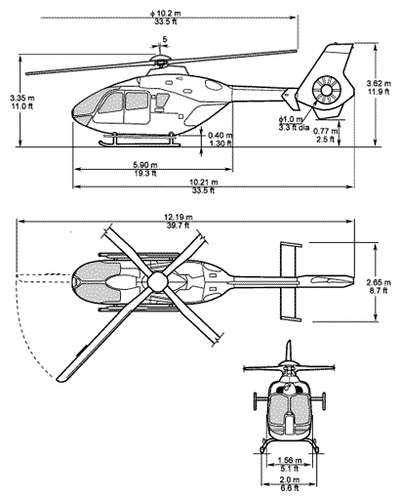EASA Reports Cracks In Hub-Shaft Flanges On Three Aircraft
The FAA has issued an Emergency AD (EAD 2012-10-51) for Eurocopter Deutschland GmbH (ECD) Model EC135 P1, EC135 P2, EC135 P2+,EC135 T1, EC135 T2, and EC135 T2+ helicopters.

The European Aviation Safety Agency (EASA), which is the Technical Agent for the Member States of the European Union, has issued EASA AD No. 2012-0041-E, dated March 12, 2012 (2012-0041-E), to correct an unsafe condition for the ECD Model EC 135 helicopters. EASA advises that during an inspection of an EC 135 helicopter, a crack was detected on the lower hubshaft flange of a main rotor hub (MRH) shaft. Since issuing 2012-0041-E, two other lower hub-shaft flange cracks have been reported.
ECD is investigating the cause of the cracks and may issue a revised service bulletin with further corrective action. We are issuing this EAD to detect a crack on the hub-shaft flange, which if not corrected could result in failure of the main rotor hub and subsequent loss of control of the helicopter.
These helicopters have been approved by the aviation authority of the Federal Republic of Germany (Germany) and are approved for operation in the United States. Pursuant to a bilateral agreement with Germany, EASA, its technical representative, has notified the FAA of the unsafe condition described in the EASA AD. The FAA is issuing this EAD after evaluation of all information provided by EASA and determined the unsafe condition exists and is likely to exist or develop on other helicopters of these same type designs.
This EAD requires the following:
- Before the first flight of each day, checking the lower hub-shaft flange for a crack and each blade attachment bolt safety pin for deformation. An owner/operator (pilot) may perform the visual check required by this EAD and must enter compliance with that paragraph into the helicopter maintenance records in accordance with 14 CFR §§ 43.9(a)(1)-(4) and 91.417(a)(2)(v). A pilot may perform this check because it involves only looking at the blade bolts and safety pins and can be performed equally well by a pilot or a mechanic. This check is an exception to our standard maintenance regulations.
- If a blade bolt safety pin is deformed, which may indicate a rotated blade bolt or a crack on a hub-shaft flange, before further flight, inspecting the upper and lower hub-shaft flanges for a crack.
- Within 5 hours time in service (TIS), removing the rotor-hub cap and inspecting the upper and lower hub-shaft flanges for a crack and the blade attachment bolts for deformed safety pins.
- If there is a crack, replacing the MRH shaft.
The EASA AD requires the visual inspection to be accomplished within 100 flight-hours, while this EAD requires the inspection within 5 hours TIS. The EASA AD requires you to report the findings and send any cracked MRH to ECD, and this EAD does not.
The FAA considers this EAD to be an interim action. The design approval holder is currently developing a modification that will address the unsafe condition identified in this EAD. Once this modification is developed, approved, and available, the agency says it might consider additional rulemaking.
FMI: AD
 NTSB Final Report: Rutan Long-EZ
NTSB Final Report: Rutan Long-EZ ANN FAQ: Turn On Post Notifications
ANN FAQ: Turn On Post Notifications Classic Aero-TV: ICAS Perspectives - Advice for New Air Show Performers
Classic Aero-TV: ICAS Perspectives - Advice for New Air Show Performers ANN's Daily Aero-Linx (06.28.25)
ANN's Daily Aero-Linx (06.28.25) Aero-News: Quote of the Day (06.28.25)
Aero-News: Quote of the Day (06.28.25)



